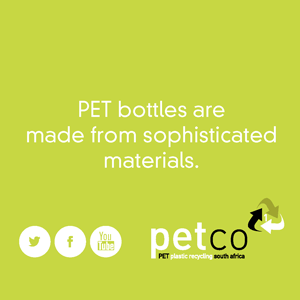
• Design PET containers with the recycling process in mind
• Sustainable recycling starts with a recyclable bottle
• Include recycled, post-consumer PET (rPET) in your packaging
• Consider the relevant ISO Standard
Packaging shape
Good packaging form design can encourage reduction of content waste. For bottles, examples include wide necks (which also assist in washing the bottle at the recycler) or the ability to normally stand the bottle upside down with product settling at the neck.
Choosing the right material type(s)
The extent to which different polymers can be recycled together is important when designing for recycling. The aim is to minimise the number of different plastics used, and to specify plastics that can be recycled together or easily separated during recycling.
• Ideally, where combined for one package, materials of different densities should be used to facilitate the separation of incompatible materials during mechanical shredding or crushing, or during water-based washing processes.
• Combinations of different types of plastic with the same density ranges should be avoided.
• Fillers that change the density of the plastic should be avoided or their use minimised
• PVC contamination is a potentially major problem, as the similar appearance and overlapping range of densities make the two polymers difficult to separate.
• Use of PLA (a biodegradable material) with PET should be avoided, as the polymers are incompatible and not readily separable
• Composite materials: where a composite material is necessary, the ideal would be to use thin layers (e.g. nylon, vapour deposition). Lightweight plastic laminates (especially those of thickness <100 microns) are not cost-effective to recycle. EVOH as a potential barrier material with PET is currently not recommended.
• Clear plasma coatings in general do not cause recycling issues, but high levels of carbon should be avoided. Other external coatings (e.g. O2 or CO2 barriers) can cause issues
• Where performance-enhancing barrier layers which could interfere with current recycling are used (e.g. in PET beer bottles, it is important to ensure that the container can be easily distinguished and sorted from conventional PET bottles.
Plastic colour and labelling
• Coloured plastic material has a much lower economic value than non-pigmented plastic.
• Coloured sleeves offer an alternative to coloured bottles. Sleeves and safety seals should be designed to completely detach from the container, or else they become contaminants.
• Avoid direct printing onto PET.
• Where possible, avoid using additives which cause the PET to discolour and/or haze
• Polyethylene and polypropylene are the preferred label materials, and should be designed such that they do not delaminate in the washing process.
• Paper labels are not ideal. Paper labels on plastic film represent a significant problem to conventional recycling.
• Avoid foil labels on film represents a significant problem to conventional recycling since they are costly to remove, increase contamination, and significantly devalue the quality of the collected material.
• Deposition techniques that provide a very thin layer of metal (only atoms deep) are acceptable and are the method of choice to provide a metallised effect on labels
Also important:
• Avoid foil safety seals that leave remnants of foil and/or adhesives
• Ideally, bottle caps and closures should all be recyclable themselves.
• Avoid using PET closures on PET bottles. Ideally use PP or HDPE.
• Avoid metal caps, since they are difficult and costly to remove.
• Avoid metal inks for printing (they could contaminate the recovered plastic), or inks that would dye the wash solution
• Avoid using components of a different material for pour spouts and handles, since they could reduce base resin yield and increase separation costs. Where required, use compatible, unpigmented materials
• Consider the possibility of including recycled plastics in packaging for both environmental and commercial reasons
Material Identification
• To facilitate the visual identification of plastic types during manual separation, major plastic components (container, caps, and lids) should carry a material identifier.
• The symbol should be shown clearly and ideally moulded into the container.
• For consistency, material identifiers should be embossed on the base of a container. Exceptionally, the identifier could be close to the base or printed on the label.
PETCO acknowledges that guidance on designing for recyclability is one component only of a larger sustainability challenge. There are wider issues of relevance, both in considering the overall environmental impact of differentiated packaging systems, and in developing efficient operational solutions to recycling and recovery of used plastic packaging. A more detailed document is available from the PETCO website.
For more information please contact:
info@petco.co.za
0860 147 738
www.petco.co.za
Facebook: 1isPET / Twitter: 1isPET
Consider the relevant ISO Standard
The Type ll ISO 14021 1999 Self-declared ISO (International Organization for Standardisation) standard addresses twelve environmental claims that designers should keep in mind:
• Recyclable
• Recycled Content
• Reduced Resource Use
• Recovered Energy
• Waste Reduction
• Reduced Energy Consumption
• Reduced Water Consumption
• Extended Life Product
• Reusable and Refillable
• Designed for Disassembly
• Compostable and
• Degradable.




 Publications
Publications
 Partners
Partners










